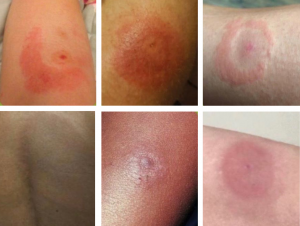Children First Medical Group
Our Latest Blogs
Read more. Know more.
April 25, 2024
Beware the Tick, Don’t Get Sick
With the beautiful weather in spring and summer, it is always a great idea to spend time outdoors. Whether it is hiking, camping, or even gardening, just be sure to protect yourself from pests such as ticks and their potential complications!
What is Lyme Disease?
Lyme disease is the most common tick-borne disease in the United States caused by the bacterium Borrelia burgforferi. Infected black-legged ticks (also known as deer ticks) feed on both humans and animals like our furry friends! Ticks like to come out more between April and September.

Symptoms include fever, headache, fatigue, and a skin rash called erythema migrans (EM). The rash typically is at the site of the tick bite and has a bull’s eye shape. Most people don’t usually know they had a tick bite until they discuss with their doctors the symptoms they are experiencing. The rash usually forms about a week after the bite but can appear between 3 to 30 days after. To see pictures of what the rash looks like, refer to this link.



Stages of Lyme Disease
There are three stages of Lyme disease: early localized disease (stage 1), early disseminated disease (stage 2), and late disseminated disease (stage 3).
During Stage 1, there are only a few symptoms at first. One sign of Lyme disease is a rash, but not everyone gets it. The rash might feel warm when you touch it, but it’s usually not painful or itchy.
Other things you might feel at this stage are a fever, headaches, extreme fatigue, stiff joints, muscle aches, and swollen lymph nodes.
If Lyme disease isn’t treated, it can lead to Stage 2. The symptoms might show up within 3 to 10 weeks after the tick bite. Stage 2 of Lyme disease is often more serious and spreads around the body. It spreads because it affects multiple body systems like the neck and impacts your overall health. On top of the symptoms from stage 1, you may also experience:
- Many rashes on other parts of your body.
- Your neck might feel stiff or painful.
- Your facial muscles might feel weak on one or both sides.
- Your heart might beat irregularly because of your immune system.
- You might feel pain starting from your back and hips and moving to your legs.
- Your hands or feet might feel numb or weak.
- Your eye or eyelid might swell painfully.
- Your immune system might affect your eye nerves, causing pain or trouble seeing.
In Stage 3, you might have symptoms from the other stages and new ones. In the United States, a common symptom at this stage is arthritis in big joints, like your knees. Pain, swelling, and stiffness may differ per person. These symptoms may last for a while or they may come and go. Stage 3 symptoms usually start 2 to 12 months after getting bitten by the tick.

It is also important to know that not all deer ticks are infected with the bacterium and not all tick bites, even if the tick is infected, result in Lyme disease in the human.
How to Prevent Tick Bites
Before you go outside,
- Know where ticks like to hang out. They love grassy, brushy, or wooded areas, especially where deer roam. Read this article to learn where ticks are more likely to be found among certain animals and in the West, white-footed mice.
- Prepare clothing and gear with products containing 0.5% permethrin (an insecticide). Use them on your boots, clothing, and camping gear or you can buy permethrin-treated clothing and gear.
- Get bug spray to keep the ticks away. Use this link to find which EPA-registered product fits you best.
- Avoid contact with ticks. Walk in the center of trails and avoid areas with high grass and leaf litter.
How to Prevent Lyme Transmission to Yourself
After coming back inside,
- Check your dogs and gear before coming inside the house if your dog is outside as well.
- Check your clothing for ticks. Ticks can stay on your clothes. Put your clothes in the dryer for 10 minutes or more on high heat to kill any ticks. If they need washing, use hot water. Cold and medium-temperature water will not kill ticks.
- Check your body for ticks. Using a mirror, do a full body check in these areas for ticks:
- Under the arms
- In and around the ears
- Inside belly button
- Back of the knees
- In and around the hair
- Between the legs
- Around the waist
 Shower soon after being outdoors. Showering within two hours of being outside can help lower your chance of getting Lyme disease.
Shower soon after being outdoors. Showering within two hours of being outside can help lower your chance of getting Lyme disease.
Sources:
https://www.cdc.gov/lyme/signs_symptoms/rashes.html
https://www.medcentral.com/infectious/lyme-disease-cases-on-the-rise-what-docs-need-to-know
https://www.cdc.gov/lyme/transmission/index.html
Lyme disease and the EM Rash
https://www.medicalnewstoday.com/articles/323457
https://www.mayoclinic.org/diseases-conditions/lyme-disease/symptoms-causes/syc-20374651
You can find them below!
